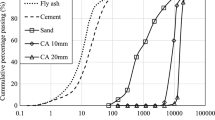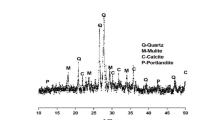Abstract
In order to examine the effect of load-induced transverse cracks on the chloride penetration in flexural concrete beams, two different concretes, Portland cement concrete (PCC) and fly ash concrete (FAC), were tested with various crack widths. Total 14 reinforced concrete (RC) beams, ten of which were self-anchored in a three-point bending mode, were immersed into a 5% NaCl solution with the condition of dry-wet cycles. Then, the free chloride ion contents were determined by rapid chloride testing (RCT) method. Based on the proposed analytical models of chloride penetration in sound and cracked concrete subjected to dry-wet cycles, the apparent chloride diffusion coefficient and chloride diffusivity of concrete were discussed. It can be found that the performance of chloride diffusivity in both concretes will be improved with the increase of crack width, and that the influence of convection action will also be augmented. Based on the two samples obtained in sound concrete after 15 and 30 cycles, the time-exponent, m, for chloride diffusion coefficient was determined to be 0.58, 0.42, 0.62 and 0.77 for PCC1, PCC2, FAC1 and FAC2 specimens, respectively. Finally, two influencing factors of fly ash content and crack width on chloride diffusivity were obtained by regression analysis of test data, and it can be seen that factors k f and k w can be expressed with quadratic polynomial functions of fly ash content, f, and crack width, w, respectively.
Similar content being viewed by others
References
AHMAD S. Reinforcement corrosion in concrete structures, its monitoring and service life prediction-a review [J]. Cement and Concrete Composites, 2003, 25(4) 459–471.
ZHENG Jian-lan, WANG Xue-fang. Influence of fly ash on early-age cracking behavior of high-flowing concrete [J]. Journal of Central South University of Technology, 2009, 16(2): 312–319.
LENG Fa-guang, FENG Nai-qian, LU Xin-ying. An experimental study on the properties of resistance to diffusion of chloride ions of fly ash and blast furnace slag concrete [J]. Cement and Concrete Research, 2000, 30(6): 989–992.
MOHAMMED T U, HAMADA H. Relationship between free chloride and total chloride contents in concrete [J]. Cement and Concrete Research, 2003, 33(9): 1487–1490.
SENGUL O, TASDEMIR C, TASDEMIR M A. Mechanical properties and rapid chloride permeability of concretes with ground fly ash [J]. ACI Materials Journal, 2005, 102(6): 414–421.
CAO Wen-tao, YU Hong-fa, HU Die, WENG Zhi-cai. Influence of fly ash and slag on apparent chloride diffusion coefficient of concretes [J]. Journal of Wuhan University of Technology, 2008, 30(1): 48–51. (in Chinese)
ISMAIL M, TOUMI A, FRANCOIS R, GAGNE R. Effect of crack opening on the local diffusion of chloride in cracked mortar samples [J]. Cement and Concrete Research, 2008, 38(8/9): 1106–1111.
DJERBI A, BONNET S, KHELIDJ A, BAROGHEL-BOUNY V. Influence of traversing crack on chloride diffusion into concrete [J]. Cement and Concrete Research, 2008, 38(6): 877–883.
JANG S Y, KIMB B S, OH B H. Effect of crack width on chloride diffusion coefficients of concrete by steady-state migration tests [J]. Cement and Concrete Research, 2011, 41(1): 9–19.
KWON S J, NA U J, PARK S S, JUNG S H. Service life prediction of concrete wharves with early-aged crack: Probabilistic approach for chloride diffusion [J]. Structural Safety, 2009, 31(1): 75–83.
GOWRIPALAN N, SIRIVIVANTNANON V, LIM C C. Chloride diffusivity of concrete cracked in flexure [J]. Cement and Concrete Research, 2000, 30(5): 725–730.
WIN P P, WATANABE M, MACHIDA A. Penetration profile of chloride ion in cracked reinforced concrete [J]. Cement and Concrete Research, 2004, 34(8): 1073–1079.
ABABNEH A, BENBOUDJEMA F, XI Y. Chloride penetration in nonsaturated concrete [J]. Journal of Mater Civil Engineering, 2003, 15(2): 183–191.
JIN Wei-liang, JIN Lin-bing, YAN Yong-dong, YAO Chang-jian. Field inspection on chloride ion-intrusion effect of seawater in dry-wet cycling zone of concrete structures [J]. Journal of Hydraulic Engineering, 2009, 40(3): 364–371. (in Chinese)
ISHIDA T, IQBAL P O, ANH H T L. Modeling of chloride diffusivity coupled with non-linear binding capacity in sound and cracked concrete [J]. Cement and Concrete Research, 2009, 39(10): 913–923.
YAN Yong-dong. Transportation of chloride ions in damaged and cracked concrete and its action [D]. Zhejiang: Zhejiang University, 2011: 13–55. (in Chinese)
ENGELUND S, EDVARDSEN C, MOHR L. General guidelines for durability design and redesign [R]. The European Union-Brite EuRam III, BE 95-1347/R15, DuraCrete, 2000: 37–38.
YU Hong-fa. Study on high performance concrete in salt lake: Durability, mechanism and service life prediction [D]. Nanjing: Southeast University, 2004: 112–123. (in Chinese)
HELLAND S. Assessment and prediction of service life for marine structures-a tool for performance based requirement? [C]// In: 2nd DuraNet Workshop & CEN TC-104 “Design of Durability of concrete”, Berlin, 1999: 56–58.
GERARD B, MARCHAND J. Influence of cracking on the diffusion properties of cement-based materials Part I: Influence of continuous cracks on the steady-state regime [J]. Cement and Concrete Research, 2000, 30(1): 37–43.
WANG Hai-long, LU Chun-hua, JIN Wei-liang, BAI Yun. Effect of external loads on chloride transport in concrete [J]. Journal of Materials in Civil Engineering, 2011, 23(7): 1043–1049.
Author information
Authors and Affiliations
Corresponding author
Additional information
Foundation item: Projects(50908103, 51278230, 51378241) supported by the National Natural Science Foundation of China; Project(2012M511215) supported by China Postdoctoral Science Foundation; Project(11JDG132) supported by the High-grade Talent Program of Jiangsu University, China; Project(2011CEM010) supported by State Key Laboratory Foundation of High Performance Civil Engineering Material, China; Project(20123227110006) supported by Doctoral Foundation of Ministry of Education of China
Rights and permissions
About this article
Cite this article
Lu, Ch., Cui, Zw., Liu, Rg. et al. Chloride diffusivity in flexural cracked Portland cement concrete and fly ash concrete beams. J. Cent. South Univ. 21, 3682–3691 (2014). https://doi.org/10.1007/s11771-014-2351-3
Received:
Accepted:
Published:
Issue Date:
DOI: https://doi.org/10.1007/s11771-014-2351-3




